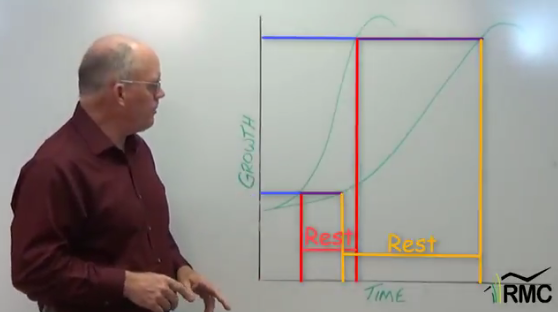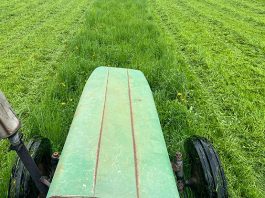 Toxic-endophyte tall fescue (predominantly Kentucky-31) makes up over 90 percent of tall fescue acres in the US and costs the cattle industry over $1 billion every year in lost productivity. The losses caused by the toxic endophyte may not be immediately apparent without close tracking and observation, or the ability to directly compare and measure the performance of healthy animals with that of animals exposed to the toxic endophyte.
Toxic-endophyte tall fescue (predominantly Kentucky-31) makes up over 90 percent of tall fescue acres in the US and costs the cattle industry over $1 billion every year in lost productivity. The losses caused by the toxic endophyte may not be immediately apparent without close tracking and observation, or the ability to directly compare and measure the performance of healthy animals with that of animals exposed to the toxic endophyte.
The endophyte, Neotyphodium coenophialum, exists in a symbiotic relationship with the fescue plant. It establishes between the cells of the plant, while imparting on the host fescue plant protection against a range of stress factors– including insects, disease, drought stress, and herbivory (feeding on the plant by herbivorous animals). This last stress factor should sound familiar, because it’s the one that we are in direct conflict with in managing our herbivores (cattle). By causing problems to the animal, the endophyte is discouraging grazing and protecting the regrowth potential of the plant. This means that operators who graze animals on K-31 fescue have one less layer of management to worry about – there is less need to rotate intensively when the plants themselves have built in protection against overgrazing.
This, and the plants’ resulting hardiness can make K-31 fescue seem worthwhile, until the effects are taken into account. Some toxic effects on the animal produced by the endophyte’s ergot alkaloids include:
-

An example of fescue foot. Poor circulation – tail switches and hooves can fall off (“fescue foot”)
- Body temperature 3-4 degrees higher than normal; maintaining rough hair coats (extra hair contributes to higher body temperature)
- Low prolactin (hormone required for milk production)
- Drop in animal production, averaging 25% less milk, 20% less time spent grazing, drinking 25% more water, loss of 2 points in body condition, calf weaning weights 60-90 lbs lighter, and 40% less gain.
Dilution
The most typical response to toxic fescue stands has been dilution, since the toxic effects will be greatly reduced with other species or types of feed mixed in. The ergot alkaloids produced by the toxic endophyte won’t be a concern for the animals if less than 20 percent of the feed is infected with the toxic endophyte. Cattlemen often try to dilute the stand by interseeding clovers or clover-grass mixes. This does not have a high success rate in the absence of a highly intensive rotational grazing system, since cattle select the more palatable interseeded clovers and grasses, quickly favoring and selecting for the toxic fescue.
Another widely used practice is to suppress the seedheads (the area of highest endophyte concentration within the plant) by spraying herbicides just prior to seedhead development. The only herbicide labeled for this practice is metsulfuron, (brand name Chaparral). You’ll get the side benefits of broadleaf control in pastures, but the herbicide will also have a stunting effect on the stand for weeks after the application, making reduced yields likely.
Full renovation is the best option
Replacing the stand with novel endophyte or endophyte-free fescues is the only long-term solution to fescue toxicity. The endophytes contained in these varieties don’t produce the harmful ergot alkaloids, but provide other alkaloids needed to improve plant persistence.
 BarOptima E34 tall fescue, for example, contains a strain of the endophyte fungus that protects the plant without producing the harmful toxin threatening to animal health. Martin II contains the novel endophyte Protek, and Cajun II, STF-43, and Kora are endophyte-free varieties.
BarOptima E34 tall fescue, for example, contains a strain of the endophyte fungus that protects the plant without producing the harmful toxin threatening to animal health. Martin II contains the novel endophyte Protek, and Cajun II, STF-43, and Kora are endophyte-free varieties.
Fully getting rid of the toxic fescue and controlling later volunteer emergence will be necessary for the new stand to succeed, as the toxic fescue can leave a large seed bank in the soil.
The spray-smother-spray technique is a common means to renovate a K-31 stand. Kill the toxic endophyte fescue with 2 quarts/A glyphosate in the spring when the fescue is actively growing. A second application may be needed if any survives.
Plant a warm-season grass such as sorghum-sudan, millet, or a summer blend that incorporates other species like cowpeas or brassicas, and control any fescue that reappears. After a late summer harvest of the annual, spray and kill again. Wait a couple of weeks to see if any more fescue emerges. After another week, the pasture can be replanted with the non-toxic seed.
Once the novel endophyte fescue is established, maintaining the stand requires more management than K-31. Cows will graze it more aggressively because of the softer, more palatable leaves and the lack of toxicosis effects, so rotate the animals frequently (at 3-4” residual) to prevent over-grazing. Leaving a solid amount of residual gives a stronger stand that will bounce back better in the face of drought.
It is especially important to avoid overgrazing in the periods when fescue growth is less active, like the late spring and summer.
For the first two years of the novel endophyte stand, control seedhead production closely – this may mean clipping regularly in addition to a tight grazing rotation. In the case of volunteer K-31, this minimizes the spread of the harmful endophyte (it is spread to the next generation through the seed), as well as preventing K-31 from becoming an increasing proportion of the stand.
Since K-31 can be so aggressive, a full-cycle rotation period with at least a year of small grains or row crops is ideal for beating back lingering volunteers.
K-31’s tenacity and its positive agronomic attributes lead many growers to overlook the detriments to nutrition and animal health, especially when those costs aren’t measured and compared to the alternative. Cost is a major deterrent to full renovation and replacement of the stand, and it may be hard to justify the cost when you haven’t done the math to measure the long-term potential benefits (especially when some lags in animal productivity may be slipping under the radar). When you understand the long term costs in animal performance, transitioning to novel endophyte fescue will likely be the more economical choice. Many producers try to piece together a variety of solutions, including seedhead suppression, overseeding legumes and other grasses, and supplementing other feedstuffs to dilute the toxin effect in the diet, but replacing the stand entirely will be the most cost-effective long-term answer.





Coming to Missouri in 1993 from the upper Midwest I was naïve to toxic fescue and the farm I had purchased was hotter than a $2 pistol. Seeking remedies I learned from numerous trials that endophyte free fescue could not be counted on to persist more than 1-3 years. Thus I set out to mitigate the presence of the toxin through all the strategies your article mentioned, and more. Still I could not get the production (cow/calf) my calculations indicated were physiologically attainable by the animal. When novel endophyte fescue came along in 2000 I began to renovate. By 2013 my farm was 100% novel. I keep my cattle records on MS Access; 29 data points on each cow & 33 on each calf. My stocking rate is 1.52 ac/cow. My records indicate I have the $200/ac renovation cost back in about the same number of years as my stocking rate; i.e. 1.6 years payback. I’d never go back to KY-31. I humbly suggest you caution readers on the failure of endophyte free fescue to persist. The literature clearly indicates it does not survive.
Comments are closed.